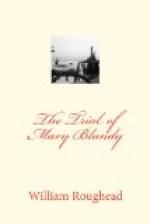Walpole barely exaggerates the wholesale legal butcheries by which the streets of London were then disgraced. “Many cartloads of our fellow-creatures are once in six weeks carried to slaughter,” says Henry Fielding, in his Enquiry (1751); and well has Mr. Whibley described the period as “Newgate’s golden age.” As for Tyburn Tree, we read in its Annals, for example, “1752. July 13. Eleven executed at Tyburn.”
We can only glance at one or two further instances of the diffusion of “Blandy’s fatal fame.” None of the varied forms of the Newgate Calendar—that criminous Who’s Who?—fails to accord her suitable if inaccurate notice. With other letter-writers of the time than the genial Horace the case forms a topical subject. James Granger reports to a reverend correspondent that “the principal subject of conversation in these parts is the tragical affair transacted at Henley.... It is supposed, as there is no direct and absolute proof that she was guilty, and her friends are rich and have great interest, that she will escape punishment.” To Mrs. Delany, writing the day after the execution, the popular heroine “appeared very guilty by her trial,” but we learn that Lady Huntingdon had written a letter to Miss Blandy after her conviction. On 22nd April, 1752, Miss Talbot writes to Mrs. Carter, who thought Mary had been “too severely judged,” that “her hardiness in guilt” was shocking to think of. “Let me tell you one fact that young Goosetree, the lawyer, told to the Bishop of Gloucester,” she writes, with reference to Miss Blandy’s repeated statement that she never believed her father a rich man. “This Goosetree visited her in jail as an old acquaintance. She expressed to him great amazement at her father’s being no richer, and said she had no notion but he must have been worth L10,000. Mr. Goosetree prudently told her the less she said about that the better, and she never said it afterwards, but the contrary.” Miss Talbot adds that certain letters in Lord Macclesfield’s hands “falsify others of her affirmations.” By 5th May, 1753, Mrs. Delany writes, “We are now very full of talk about Eliza Canning.”
As time goes on the tragedy of Henley, though gradually becoming a tradition, is still susceptible of current allusion. John Wilkes, writing from Bath to his daughter on 3rd January, 1779, regarding a lady of their acquaintance who proposed to keep house for a certain doctor, remarks “that he is sure it could not have lasted long, for she would have poisoned him, as Miss Blandy did her father, and forged a will in her own favour”; but Tate Wilkinson, in his Memoirs, observes, “Elizabeth Canning, Mary Squires, the gipsy, and Miss Blandy were such universal topics in 1752 that you would have supposed it the business of mankind to talk only of them; yet now, in 1790, ask a young man of twenty-five or thirty a question relative to these extraordinary personages, and he will be puzzled to answer, and will say, ’What




